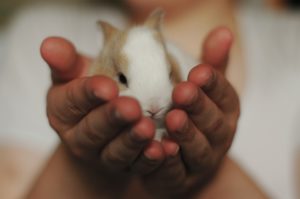Seven Tips for Introducing Children to Pets
Cats, dogs, bunnies, hamsters, birds, lizards, snakes, and fish- oh my! Introducing children to pets is a huge step in the direction of creating kind, compassionate, and responsible future pet owners. But sometimes, the introductions may go awry. Pulled tails, nipped fingers, petting too rough, holding too tight, and hurt feelings on all sides can sometimes be the outcome of first meeting a pet.
Here are some tips to help introduce children to pets big and small with as little tears, yelps, squeaks, and hisses as possible.
 1.Read children’s books about pets, pet ownership, or the specific kind of pet.
1.Read children’s books about pets, pet ownership, or the specific kind of pet.
Education and keeping your child informed is a great way to start off introducing a child to a new pet. There are a plethora of children’s books geared towards pet ownership and animals. Learning and understanding about anything makes children (and yes, adults too) more comfortable and less scared. If you introduce your child to the responsibilities of pet ownership before adopting, chances are your child will be even more curious and willing to look after the new addition to the family.
2.Supervision is key!
When introducing a child of any age to an animal, adult supervision is mandatory. This is for the well being of both the child and the pet. Both may become frightened and aggressive. Rough play is also a huge no-no. For cats, dogs, bunnies, hamsters, rodents, reptiles, birds, and fish alike, supervision from the primary caretaker helps tremendously.
If the pet is grandma’s and your child is meeting the pet for the first time, grandma should be there. The pet will feel more comfortable being around it’s primary caretaker and the primary caretaker knows the animals habits the best. Maybe her dog Sparky nips a little when frightened. The primary care taker would then know the best course of action to take to avoid nipping, yipping, and hurt feelings.
 3.Demonstrate holding small animals and petting.
3.Demonstrate holding small animals and petting.
This rule of thumb can change how your child feels about animals. Petting too rough or holding a bunny, hamster, or other small pet too tight could result in scratches and bites that could be avoided. Before letting the child hold the animal, demonstrate how to do it yourself. Gently hold the pet and explain to the child that holding them gently will make the pet feel better. Demonstrate proper petting techniques and then encourage the child to try. If the pet gets squirmy or seems to be stressed, calmly explain to the child to put them down gently or back in their cage. Being calm is best and using a soft tone of voice will make both the child and pet less anxious. Another good rule of thumb is to not yell at the child if they make a mistake. Calmly explain the rules and try again.
4. Keep large animals on leashes at first.
Large dogs, or hyper dogs, may want to be leashed at first meeting with a child. Dogs and puppies get excited with new experiences and may unintentionally hurt the child by jumping. To reduce this risk, leash the dog regardless if the child is meeting them inside or outside of the home. This way the owner can control the situation and use other training techniques to calm the dog. This is also makes it easier to remove the dog from the environment if the child seems scared or anxious.
5.Introduce them in a calm area.
Loud, hectic environments can be scary and stress inducing. Small pets and large pets alike always do better in calm, controlled areas when meeting someone or doing something new. A calm environment will reduce the stress for both the child and the pet. Bunnies are particularly sensitive to loud noise, rapid movement, and chaotic environments. Bunnies are startled easy and usually do better with older children.
 6.How to play with animals and their toys.
6.How to play with animals and their toys.
Pets can be territorial about their toys and food. Small children should be taught to never take a toy away from an animal or put their hands in or near the animal’s food while eating. This step can be easily forgotten because it is only natural for children to want to play with their pet’s toys. Remind the child that pets may not understand sharing as well as they do. Teach the child that taking a toy from a pet can be dangerous. Playing with the pet under adult supervision, especially when playing with toys, is a must.
7.If the child or pet seems timid, try again later.
Like any new situation, introducing your child to a pet can be scary for everyone. Stay calm and if aggression, agitation, or fear is exhibited by the pet or the child, it may be best to try again later. Exposing your children to pets may be scary, but it enriches their lives all the more.
What suggestions do you have for introducing kids to pets? Leave a comment and let us know!
